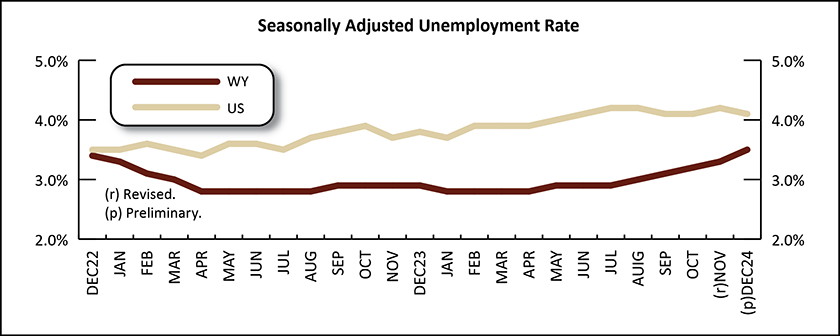Wyoming Labor Force Trends
February 2025 | Volume 62, No. 2
Click Here for PDF
Return to Table of Contents
Wyoming Unemployment Rises to 3.5% in December 2024
by: David Bullard, Senior Economist
The Research & Planning section of the Wyoming Department of Workforce Services reported that the state’s seasonally adjusted1 unemployment rate rose from 3.3% in November to 3.5% in December. Wyoming’s unemployment rate has been gradually trending upward for the past few months. It is higher than its December 2023 level of 2.9%, but still remains lower than the current U.S. rate of 4.1%.
From November to December, most county unemployment rates followed their normal seasonal pattern and increased. Jobless rates often rise in December as colder weather brings seasonal job losses in construction and other sectors. The largest unemployment rate increases occurred in Niobrara (up from 2.6% to 3.6%), Big Horn (up from 3.8% to 4.4%), and Sweetwater (up from 3.7% to 4.3%) counties. Teton County’s unemployment rate fell from 4.3% in November to 3.0% in December as the winter tourist season ramped up. Johnson County’s unemployment rate remained unchanged at 3.3%.
From December 2023 to December 2024, unemployment rates rose in every county. The largest increases were found in Hot Springs (up from 2.3% to 3.9%), Sublette (up from 3.1% to 4.7%), and Sweetwater (up from 2.9% to 4.3%) counties.
Converse, Teton, and Weston counties tied for the lowest unemployment rate in December, each at 3.0%. The highest unemployment rates were reported in Sublette County at 4.7%, Big Horn County at 4.4%, and Sweetwater County at 4.3%.
Current Employment Statistics (CES) estimates show that total nonfarm employment in Wyoming (not seasonally adjusted and measured by place of work) rose from 290,800 in December 2023 to 295,900 in December 2024, an increase of 5,100 jobs (1.8%).
R&P's most recent monthly news release is available at https://doe.state.wy.us/LMI/news.htm.



 Hire Wyo
Hire Wyo